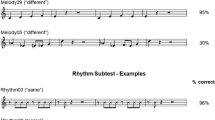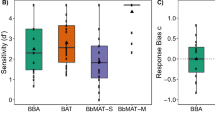Abstract
The ability to discriminate and reproduce a rhythmic sequence of sounds is considered to reflect a combination of maturation and experience. This study aimed to assess age-related decrements in reproduction of rhythmic patterns in musically untrained adults (range 25–54 years), young-old (range 60–69 years), and old (range 70–79 years) individuals, and co-aged old (range 60–79 years) musicians. Participants were required to reproduce on an electronic pad three rhythmic sequences differing in time signature (meter), inter-event ratio and tempo. Differences between the standard and its reproductions in number of events, total duration and ratio among rhythmic events were calculated. All variables showed that rhythmic ability is negatively affected by aging, with lengthening errors of total duration increasing markedly after 60 years of age. However, reproductions were positively affected by expertise. The results suggest that training can effectively counteract decremental trend in rhythmic reproduction ability that emerges with aging.




Similar content being viewed by others
References
Persichini C, Capranica L (2004) Reproduction of rhythmic patterns in young individuals: toward the construction of a computerized rhythmic test. Int J Sport Psychol 35:246–265
Ragot R, Fernandez AM, Pouthas V (2002) Time, music, and aging. Psychomusicology 18:28–45
Warren RM (1993) Perception of acoustic sequences: global integration versus temporal resolution. In: McAdams S, Bigand E (eds) Thinking in sound: the cognitive psychology of human audition. Clarendon Press, Oxford, pp 37–68
Cazzago P (1986) Psicomotricità e spazio—tempo. Strutture e ritmi. La Scuola, Brescia, Italy
Halpern AR, Bartlett JC (2002) Aging and memory for music: a review. Psychomusicology 18:10–27
McAdams S, Bigand E (1993) Introduction to auditory cognition. In: McAdams S, Bigand E (eds) Thinking in sound: the cognitive psychology of human audition. Clarendon Press, Oxford, pp 1–10
Van Donkelaar P, Franks IM (1991) The preparation and initiation of simple rhythmical patterns. Hum Mov Sci 10:629–651
Clynes M, Walker J (1982) Neurobiologic functions of rhythm, time, and pulse in music. In: Clynes M (ed) Music mind and brain: the neuropsychology of music. Music Research Center, New South Wales State Conservatorium of Music, Sidney, pp 171–216
Spirduso W, Francis KL, MacRae PG (2005) Physical dimensions of aging, 2nd edn. Human Kinetics Publ., Champaign
Peretz I (1993) Auditory agnosia: a functional analysis. In: McAdams S, Bigand E (eds) Thinking in sound: the cognitive psychology of human audition. Clarendon Press, Oxford, pp 199–230
Hausdorff JM, Peng CK, Ladin Z, Wei JY, Goldberger AL (1995) Is walking a random walk? Evidence for long-range correlations in stride interval of human gait. J Appl Physiol 78:349–358
Chen Y, Ding M, Kelso JAS (2001) Origin of timing errors in human sensorimotor coordination. J Mot Behav 33:3–8
Chen Y, Ding M, Kelso JAS (1997) Long memory processes (1/fα Type) in human coordination. Phys Rev Lett 79:4501–4504
Ijspeert AJ (2008) Central pattern generators for locomotion control in animals and robots: a review. Neural Netw 21:642–653
Ivanenko YP, Poppele RE, Lacquaniti F (2006) Motor control programs and walking. Neuroscientist 12:339–348
Golubitsky M, Stewart I, Buono PL, Collins JJ (1999) Symmetry in locomotor central pattern generators and animal gaits. Nature 401:693–695
Birren JE, Woods AM, Williams MV (1980) Behavioural slowing with age: causes, organization, and consequences. In: Poon LW (ed) Aging in the 1980s. American Psychological Association, Washington, DC, pp 293–308
Thaut M, Rathbun J, Miller R (1997) Music versus metronome timekeeper in a rhythmic motor task. Int J Arts Med 5:4–12
Zendel BR, Alain C (2012) Musicians experience less age-related decline in central auditory processing. Phychol Aging 27:410–417
Krampe RT (2002) Aging, expertise and fine motor movement. Neurosci Biobehav Rev 26:769–776
Krampe RT, Engbert R, Kliegl R (2002) The effects of expertise and age on rhythm production: adaptations to timing and sequencing constraints. Brain Cogn 48:179–194
Krampe RT, Engbert R, Kliegl R (2001) Age specific problems in rhythmic timing. Psychol Aging 16:12–30
Block RA, Zakay D, Hancock PA (1988) Human aging and duration judgments: a meta-analysis review. Psychol Aging 13:584–596
Fraisse P (1982) Rhythm and tempo. In: Deutsch D (ed) The psychology of music. Academic Press, New York, pp 149–180
Sakai K, Hikosaka O, Miyauchi S, Takino R, Tamada T, Iwata NK, Nielsen M (1999) Neural representation of a rhythm depends on its interval ratio. J Neurosci 19:10074–10081
Drake C (1993) Reproduction of musical rhythms by children, adult musicians, and adult nonmusicians. Percept Psychophys 53:25–33
Essens PJ (1986) Hierarchical organization of temporal pattern. Percept Psychophys 40:69–73
Essens PJ, Povel DJ (1985) Metrical and nonmetrical representations of temporal patterns. Percept Psychophys 37:1–7
Trehub SE, Hannon EE (2009) Conventional rhythms enhance infants’ and adults’ perception of musical patterns. Cortex 45:110–118
Summers JJ (1975) The role of timing in motor program representation. J Mot Behav 7:229–241
Jones MR (1987) Dynamic pattern structure in music: recent theory and research. Percept Psychophys 41:621–634
Povel DJ (1981) Internal representations of simple temporal patterns. J Exp Psychol Hum Percept Perform 7:3–18
Hulstijn W, Summers JJ, Van Lieshout PHM, Peters HFM (1992) Timing in finger tapping and speech: a comparison between stutterers and fluent speakers. Hum Mov Sci 11:113–124
Miller GA (1956) The magical number seven, plus or minus: some limits on our capacity for processing information. Phychol Rev 63:81–97
Fraisse P (1974) Psychologie du rythme. Presses Universitaires de France, Paris
Rosenbaum DA, Kenny SB, Derr MA (1983) Perception of temporal patterns. Music Percept 2:411–440
Garner WR, Gottwald RL (1968) The perception and learning of temporal patterns. Q J Exp Psychol 20:97–109
Iannarilli F, Vannozzi G, Iosa M, Pesce C, Capranica L (2013) Effects of task complexity on rhythmic re production performance in adults. Hum Mov Sci 32:203–213
Osness WH, Adrian M, Clark B, Hoeger W, Raab D, Wiswell R (1996) Functional fitness assessment for adults over 60 years. Kendall/Hunt, Dubuque
Summers JJ, Pressing J (1994) Coordinating the two hands in polyrhythmic tapping. In: Swinnen SP, Heuer H, Massion J, Casaer P (eds) Interlimb coordination: neural, dynamical and cognitive constraints. Academic Press, New York, pp 571–591
Williams LRT (1985) Serial movement timing and musical experience. Percept Mot Skills 60:31–36
Schaefer S, Schumacher S (2011) The interplay between cognitive and motor functioning in healthy older adults: findings from dual-task studies and suggestions for intervention. Gerontology 57:239–246
Pesce C, Guidetti L, Baldari C, Tessitore A, Capranica L (2005) Effects of aging on visual attentional focusing. Gerontology 51:266–276
Roux F, Ceccaldi M (2001) Does aging affect the allocation of visual attention in global and local information processing? Brain Cogn 46:383–396
Sullivan MP (1999) The functional interaction of visual-perceptual and response mechanisms during selective attention in young adults, young-old adults, and old-old adults. Percept Psychophys 61:810–825
Pesce C, Cereatti L, Casella R, Baldari C, Capranica L (2007) Preservation of visual attention in older expert orienteers at rest and under physical effort. J Sport Exerc Psychol 29:78–99
Wearden JH, Wearden AJ, Rabbitt PMA (1997) Age and IQ effects on stimulus and response timing. J Exp Psychol Hum Percept Perform 23:962–972
Krampe RT, Ericsson KA (1996) Maintaining excellence: deliberate practice and elite performance in young and older pianists. J Exp Psychol General 125:331–359
Conflict of interest
None.
Author information
Authors and Affiliations
Corresponding author
Rights and permissions
About this article
Cite this article
Iannarilli, F., Pesce, C., Persichini, C. et al. Age-related changes of rhythmic ability in musically trained and untrained individuals. Sport Sci Health 9, 43–50 (2013). https://doi.org/10.1007/s11332-013-0144-y
Received:
Accepted:
Published:
Issue Date:
DOI: https://doi.org/10.1007/s11332-013-0144-y




